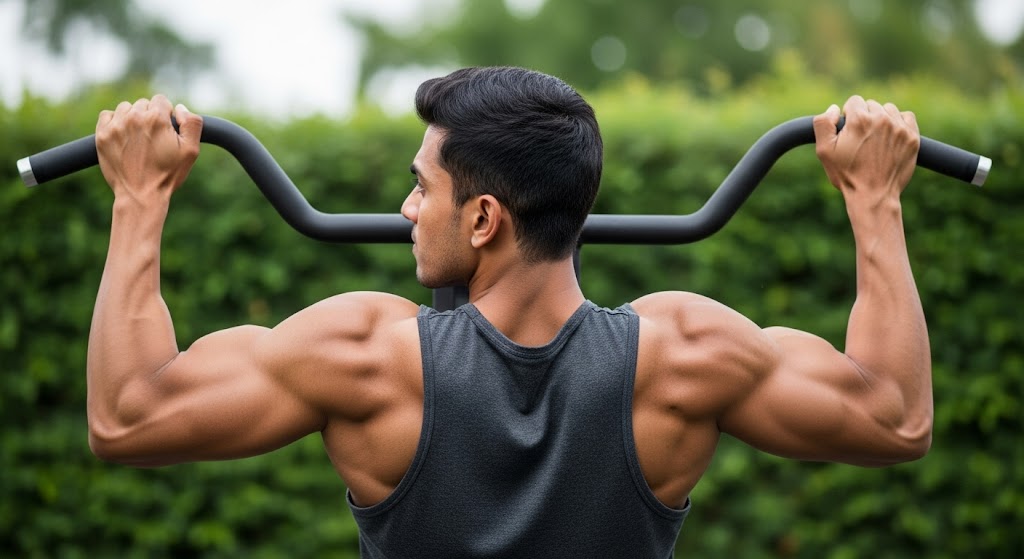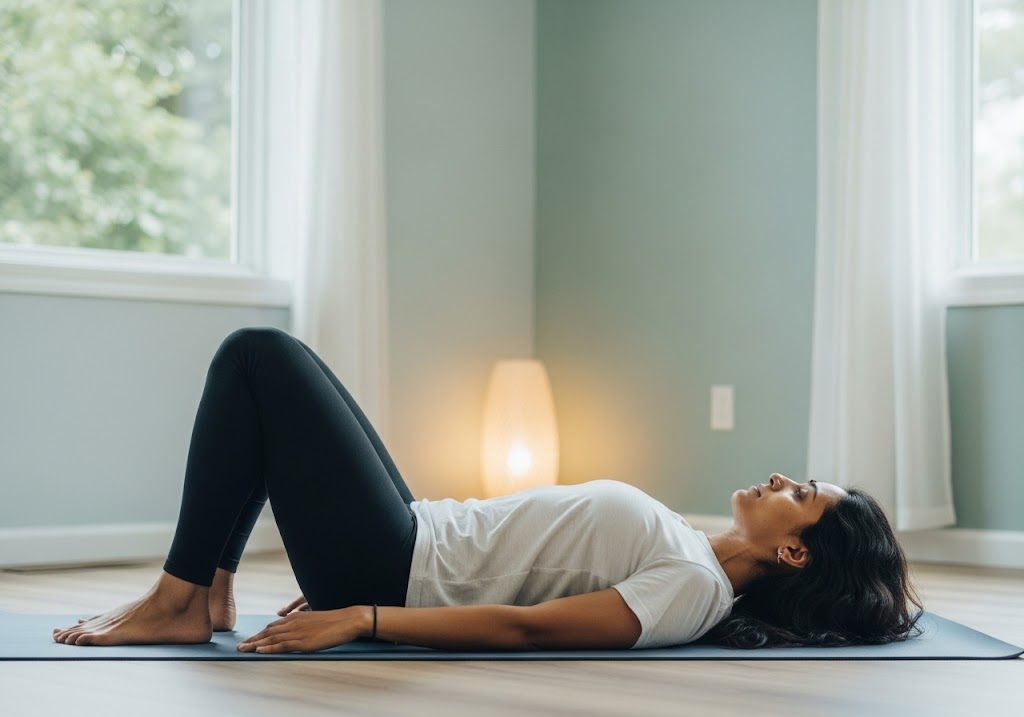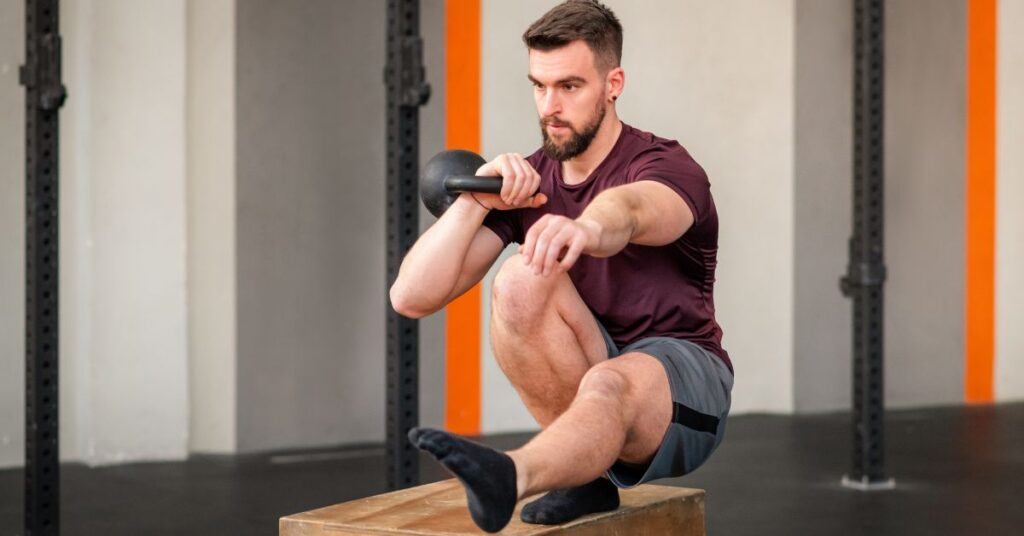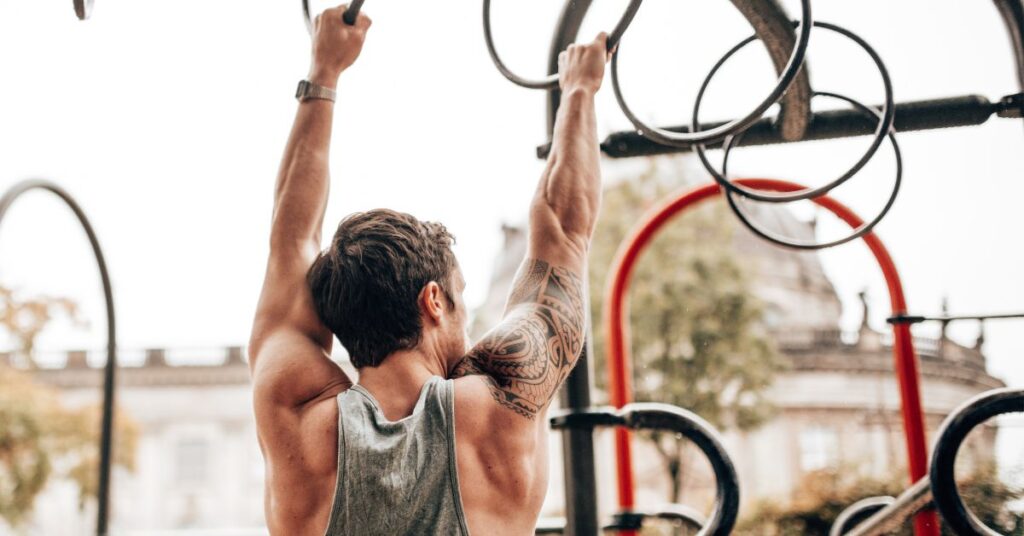10 Best Back Calisthenics Workout are: Pull-ups for lats, Chin-ups for biceps and traps, Australian Pull-ups for rhomboids, Superman for lower back, Reverse Snow Angels for rear delts, Bridge for glutes and hamstrings, Archer Pull-ups for unilateral back strength, Commando Pull-ups for lats and core, Wide-grip Pull-ups for upper traps, and L-sit Pull-ups for core and lats.
Back calisthenics represents the pinnacle of functional bodyweight training, offering a comprehensive approach to building back strength without requiring expensive equipment or gym memberships. Through strategic implementation of back calisthenics movements, practitioners can develop impressive pulling power, enhance postural alignment, and create a resilient posterior chain.
Table of Contents
What Is Back Calisthenics?
Back calisthenics fundamentally transforms how we approach posterior muscle development through intelligent bodyweight training methodologies.
This training encompasses a systematic approach to strengthening the posterior chain using only your body weight as resistance. Unlike traditional weight training, this methodology harnesses gravity, leverage, and body positioning to create progressive overload. Whether you’re a beginner or advanced practitioner, this approach scales perfectly to your current ability level.
This methodology extends beyond simple pull-ups, incorporating horizontal pulling patterns, isometric holds, and dynamic movements. What sets this training apart is its emphasis on movement quality over quantity, developing kinesthetic awareness and neuromuscular coordination.
Find out should you exercise with sore muscles and how to recover smart while staying consistent.

10 Best Back Calisthenics Workout
Building a strong, defined back doesn’t require expensive equipment or gym memberships. Calisthenics back exercises use your body weight to target all major back muscles, including lats, rhomboids, and traps. These movements improve posture, enhance pulling strength, and create that coveted V-taper while being accessible anywhere, anytime.
Follow our expert-designed calisthenics workout plan for consistent progress.
Exercise Overview Table
| Exercise | Primary Muscles | Difficulty Level | Equipment Needed |
|---|---|---|---|
| Pull-ups | Lats, Rhomboids, Biceps | Intermediate | Pull-up Bar |
| Chin-ups | Lats, Biceps, Middle Traps | Beginner-Intermediate | Pull-up Bar |
| Australian Pull-ups | Rhomboids, Middle Traps, Rear Delts | Beginner | Low Bar/TRX |
| Superman | Lower Back, Glutes | Beginner | None |
| Reverse Snow Angels | Rhomboids, Rear Delts, Lower Traps | Beginner | None |
| Bridge | Lower Back, Glutes, Hamstrings | Beginner | None |
| Archer Pull-ups | Lats, Rhomboids (Unilateral) | Advanced | Pull-up Bar |
| Commando Pull-ups | Lats, Core, Rhomboids | Advanced | Pull-up Bar |
| Wide-grip Pull-ups | Lats, Upper Traps | Intermediate | Pull-up Bar |
| L-sit Pull-ups | Lats, Core, Hip Flexors | Advanced | Pull-up Bar |
1. Pull-ups
The king of back exercises, pull-ups primarily target your latissimus dorsi while engaging rhomboids and middle traps. This compound movement builds serious pulling strength and creates that coveted wide back appearance. Start with assisted variations if needed, focusing on full range of motion from dead hang to chin over bar.
2. Chin-ups
Similar to pull-ups but with an underhand grip, chin-ups emphasize bicep involvement while still hammering the lats. The supinated grip position allows most people to perform more repetitions initially, making it an excellent starting point for building pulling strength. Progress by adding pauses at the top position.
3. Australian Pull-ups
Also known as inverted rows, this horizontal pulling exercise targets the middle traps and rhomboids effectively. Performed under a low bar with feet on the ground, you can easily adjust difficulty by changing body angle. This exercise perfectly complements vertical pulls and improves posture by strengthening often-neglected posterior chain muscles.
4. Superman
A fundamental lower back strengthener, the superman exercise targets the erector spinae muscles along your spine. Lying face down, simultaneously lift your chest and legs off the ground, creating a “flying” position. Hold for 2-3 seconds per rep. This exercise is crucial for spinal health and counteracts the effects of prolonged sitting.
5. Reverse Snow Angels
Performed lying face down, this exercise involves moving your arms in a reverse snow angel pattern while lifting your chest slightly. It specifically targets the often-weak lower trapezius and rear deltoids, muscles critical for proper shoulder positioning and posture. Start with small movements and gradually increase range of motion as strength improves.
6. Bridge
The bridge primarily strengthens the posterior chain, including lower back, glutes, and hamstrings. From a supine position, lift your hips toward the ceiling while squeezing glutes. This exercise improves hip mobility, strengthens the back extensors, and helps counteract hip flexor tightness from sitting. Progress to single-leg variations for increased difficulty.
7. Archer Pull-ups
An advanced unilateral variation where you pull toward one side while extending the opposite arm straight. This challenging exercise targets each side independently, revealing and correcting strength imbalances. The archer pull-up builds tremendous lat strength and serves as a progression toward the coveted one-arm pull-up. Master regular pull-ups first.
8. Commando Pull-ups
This dynamic exercise involves pulling up and over the bar, alternating sides with each rep. Commando pull-ups challenge your lats from multiple angles while engaging core muscles for stability. The rotational component adds functional strength and coordination. Start slowly to master the movement pattern before increasing speed or volume.
9. Wide-grip Pull-ups
By widening your grip beyond shoulder-width, you emphasize the upper lats and create more lat width development. This variation is typically more challenging than standard pull-ups due to decreased mechanical advantage. Focus on pulling your elbows down and back rather than just lifting your chin, maximizing lat engagement throughout the movement.
10. L-sit Pull-ups
Combining the L-sit hold with pull-ups creates an incredibly demanding exercise that simultaneously strengthens your lats, core, and hip flexors. Hold your legs parallel to the ground while performing pull-ups. This advanced movement requires significant core strength and coordination. Build proficiency in both L-sits and pull-ups separately before attempting this combination.
Explore the most effective calisthenics exercises for full-body strength, mobility, and endurance.

Key Muscles for Back Calisthenics Workout
Understanding the anatomy of your back is crucial for effective calisthenics training. The back consists of multiple muscle layers working together to create movement, stability, and posture. Knowing which muscles you’re targeting helps optimize exercise selection, improve form, and ensure balanced development across all back regions for maximum strength and aesthetics.
1. Latissimus Dorsi: The Foundation of Pulling Strength
The latissimus dorsi, commonly known as the “lats,” are the largest muscles in the upper body and are essential for effective calisthenics back exercises. These wing-like muscles play a crucial role in shoulder extension and internal rotation, enabling powerful pulling movements that are vital for calisthenics back exercises. Additionally, strong lats contribute to core stability and posture maintenance, making them foundational for any back-focused training routine.
2. Trapezius: Stabilizing the Shoulders
The trapezius muscle complex consists of upper, middle, and lower fibers, each serving distinct functions that support calisthenics back exercises. The upper traps facilitate shoulder elevation and neck support, while the middle traps are critical for scapular retraction, essential for movements like pull-ups. The lower traps aid in downward rotation and depression of the shoulder blades, ensuring stability during calisthenics workouts that require shoulder engagement.
3. Rhomboids: Enhancing Scapular Retraction
The rhomboids work in conjunction with the trapezius to enhance scapular retraction during calisthenics back exercises. By retracting the shoulder blades, these muscles play a significant role in maintaining proper posture and stabilizing the scapula during pulling movements. Strong rhomboids not only improve performance in exercises like inverted rows but also prevent injury by supporting the shoulder complex.
4. Erector Spinae: Posture and Spinal Support
This group of muscles runs along the spine and is vital for maintaining proper posture during various calisthenics back exercises and others. The erector spinae is responsible for spinal extension, lateral flexion, and rotational movements, which are crucial for a well-rounded calisthenics workout. By supporting spinal alignment, these muscles help prevent injuries and enhance overall performance in back-strengthening routines.
Build lean muscle naturally with bodyweight exercises.
Supporting Muscles to Know for Back Calisthenics Workout
While back muscles are the primary focus, several supporting muscle groups play crucial roles in calisthenics back exercises. These stabilizing and assisting muscles ensure proper form, prevent injury, and maximize performance. Understanding their involvement helps create balanced training programs and identify potential weak links that could limit your back development progress.
1. Teres Major and Minor
These small but crucial muscles assist in shoulder stability and arm rotation, playing an integral role in calisthenics back exercises. Their support allows larger muscle groups to perform complex movements more efficiently. Strengthening these muscles contributes to better form and reduced risk of injury during various calisthenics workouts.
2. Infraspinatus/Supraspinatus
Part of the rotator cuff complex, these muscles are essential for stabilizing the shoulder joint and aiding in external rotation. They play a crucial role in preventing injury during pulling movements associated with calisthenics back exercises. Incorporating exercises that target the infraspinatus and supraspinatus enhances shoulder health and supports more challenging calisthenics workouts.
3. Serratus Posterior
This often-overlooked muscle group assists in breathing mechanics and supports thoracic mobility, contributing to overall back strength. Engaging the serratus posterior during calisthenics back exercises can enhance breathing efficiency, particularly during high-intensity workouts. Strengthening these muscles is essential for optimal performance and recovery in calisthenics routines.
Compare the benefits of each in cold shower vs hot shower and see which one suits your fitness routine best.

Top Benefits of a Calisthenics Back Workout
Incorporating back calisthenics into your training routine offers a range of powerful benefits- far beyond just muscle gain. From functional strength to better posture and mobility, calisthenics back workouts are a comprehensive solution for long-term fitness and spinal health.
1. Build Functional Strength Without Weights
Calisthenics back workout routines develop strength that translates to daily activities and athletic performance. Unlike machine-based exercises, calisthenics back exercises require coordinated effort from multiple muscle groups simultaneously, creating functional strength patterns.
Know the difference: Push-ups vs Bench Press-which one wins for strength?
2. Improve Posture and Relieve Back Pain
Strategic implementation of calisthenics back exercises directly addresses postural dysfunction by strengthening posterior chain muscles responsible for spinal alignment. Regular calisthenics back workout practice counteracts forward head posture and rounded shoulders.
3. Enhance Flexibility and Mobility Naturally
Properly executed calisthenics back workout sessions actively improve flexibility and mobility. The full range of motion required in calisthenics back exercises promotes shoulder and thoracic spine mobility while strengthening end-range positions.
4. Train Anywhere: No Gym Required
The equipment-free nature of back calisthenics eliminates common barriers to consistent training. A simple pull-up bar provides everything needed for an effective calisthenics back workout.
Explore Somatic Pilates to improve body awareness, release tension, and enhance recovery.

Beginner-Friendly Calisthenics Back Workout Routine
This comprehensive calisthenics back workout establishes fundamental movement patterns while building progressive strength through structured bodyweight exercises perfect for newcomers to back calisthenics training.
- Weekly Frequency: Begin with 2-3 back calisthenics training sessions per week to allow adequate recovery between workouts. This frequency prevents overtraining while providing sufficient stimulus for strength development.
- Session Structure: Each calisthenics back workout should last 30-45 minutes including warm-up with arm circles and scapular wall slides. Dynamic preparation activates muscles and reduces injury risk.
- Core Exercises: Assisted chin-ups (3 sets of 3-8 reps), inverted rows (3 sets of 8-12 reps), superman holds (3 sets of 15-30 seconds). Progress by reducing assistance or increasing repetitions weekly in your calisthenics back exercises.
- Support Movements: Dead hangs (2 sets of 15-30 seconds) and reverse planks (2 sets of 10-20 seconds). These calisthenics back exercises build grip strength and posterior chain stability.
- Rest Periods: Allow 60-90 seconds between calisthenics back exercises to maintain proper form and training intensity. Quality repetitions supersede quantity for strength development.
This advanced calisthenics routine is perfect for building elite strength, control, and endurance.
The Importance of Back Calisthenics
Back calisthenics form the foundation of functional strength training, targeting multiple muscle groups simultaneously while improving posture, reducing injury risk, and enhancing overall athletic performance. These bodyweight exercises build real-world strength that translates to daily activities and sports.
Key Benefits
- Improved Posture: Back calisthenics strengthen the rhomboids, middle trapezius, and rear deltoids, which counteract the forward head posture and rounded shoulders common in modern sedentary lifestyles.
- Injury Prevention: A strong back provides essential support for the spine during lifting, carrying, and rotational movements, significantly reducing the risk of lower back pain and disc problems.
- Functional Strength: Unlike isolated machine exercises, back calisthenics train movement patterns that mirror real-life activities like pulling, climbing, and carrying objects.
- Core Integration: Most back calisthenics exercises engage the core muscles simultaneously, creating better inter-muscular coordination and overall stability.
- Balanced Development: These exercises help counteract the muscle imbalances created by excessive pushing movements, chest-focused training, and prolonged sitting.
- No Equipment Required: Back calisthenics can be performed anywhere with minimal or no equipment, making consistent training accessible regardless of location or budget.
- Progressive Overload: From basic inverted rows to advanced human flags, back calisthenics offer clear progression paths for long-term strength development.
- Enhanced Athletic Performance: A strong posterior chain improves performance in virtually every sport, from swimming and rock climbing to martial arts and team sports.
- Mental Health Benefits: The challenge and achievement of mastering difficult back calisthenics movements like muscle-ups and one-arm pull-ups provide significant psychological benefits and confidence.
Back Training with Calisthenics
Back calisthenics training encompasses various movement patterns and difficulty levels, allowing systematic progression from beginner to advanced. These exercises target the latissimus dorsi, rhomboids, middle trapezius, rear deltoids, and supporting muscle groups through compound movements.
Exercise Progression Table
| Exercise Level | Exercise Name | Primary Targets | Sets x Reps | Progression Notes |
|---|---|---|---|---|
| Beginner | Wall Slides | Upper traps, rhomboids | 3 x 12-15 | Focus on slow, controlled movement |
| Beginner | Prone Y-Raises | Rear delts, lower traps | 3 x 10-12 | Keep thumbs pointing up |
| Beginner | Inverted Rows (High Bar) | Lats, rhomboids, rear delts | 3 x 8-12 | Start with feet on ground |
| Beginner | Dead Hangs | Grip strength, lats | 3 x 20-30s | Build up hanging time gradually |
| Intermediate | Inverted Rows (Low Bar) | Lats, rhomboids, middle traps | 3 x 10-15 | Lower bar increases difficulty |
| Intermediate | Negative Pull-ups | Lats, rhomboids, biceps | 3 x 5-8 | Focus on 3-5 second descent |
| Intermediate | Assisted Pull-ups | Lats, rhomboids, biceps | 3 x 6-10 | Use resistance band or partner |
| Intermediate | Superman Holds | Erector spinae, glutes | 3 x 15-20s | Keep head in neutral position |
| Advanced | Pull-ups | Lats, rhomboids, biceps | 3 x 8-12 | Full range of motion required |
| Advanced | Chin-ups | Lats, biceps, rhomboids | 3 x 8-12 | Underhand grip variation |
| Advanced | Wide-Grip Pull-ups | Lats, rear delts | 3 x 6-10 | Emphasizes lat width |
| Advanced | L-Sit Pull-ups | Full back, core, hip flexors | 3 x 5-8 | Combine isometric and dynamic |
| Expert | Weighted Pull-ups | Full back complex | 3 x 6-8 | Add external resistance |
| Expert | One-Arm Pull-ups | Unilateral back strength | 3 x 3-5 | Each arm, ultimate goal |
| Expert | Muscle-ups | Full back, triceps, chest | 3 x 3-6 | Transition from pull to push |
| Expert | Human Flag (Hold) | Lats, obliques, shoulders | 3 x 10-15s | Advanced core integration |
Training Tips
Effective back calisthenics training requires strategic planning, proper technique, and consistent progression. These evidence-based guidelines optimize your training sessions, minimize injury risk, and accelerate strength gains. Following these principles ensures sustainable long-term development in your back training journey.
| Aspect | Recommendation | Details |
|---|---|---|
| Frequency | 2-3 times per week | Allow 48-72 hours recovery between sessions |
| Warm-up | 5-10 minutes dynamic | Arm circles, band pull-aparts, light movements |
| Form Focus | Quality over quantity | Perfect form prevents injury and maximizes gains |
| Progression | Gradual advancement | Master current level before advancing |
| Rest Periods | 90-180 seconds | Longer rest for strength, shorter for endurance |
| Breathing | Exhale on exertion | Breathe out during the pulling phase |

Progressions to Advance Your Back Calisthenics Practice
Advanced back calisthenics practitioners need systematic progression strategies that manipulate leverage, range of motion, and stability to continue building strength beyond foundational movements.
- Vertical Progressions: Advance from assisted chin-ups to unassisted, then to archer pull-ups and commando variations in your back calisthenics routine. Each progression increases unilateral demand and core stability requirements.
- Horizontal Advancement: Progress from bilateral inverted rows to single-arm variations with elevated feet. These calisthenics back workout modifications dramatically increase difficulty while maintaining proper movement patterns.
- Isometric Holds: Develop L-sit progressions and front lever holds through tuck, advanced tuck, and straddle positions. These static back calisthenics exercises build exceptional posterior chain strength.
- Leverage Manipulation: Adjust body positioning and range of motion to increase resistance without external weights. This back calisthenics method provides infinite scalability for continued progression.
Learn how to do dumbbell bench press with proper form for chest gains.
Expert Tips to Maximize Your Calisthenics Back Workout
Professional insights and advanced techniques can dramatically accelerate progress while preventing common plateaus that limit strength development in calisthenics back workout routines.
- Mind-Muscle Connection: Visualize target muscles working during each repetition to enhance neural activation in calisthenics back exercises. This mental focus increases muscle recruitment by up to 20% compared to mindless repetitions.
- Controlled Eccentrics: Emphasize 3-4 second lowering phases for maximum strength gains in your back calisthenics training. The eccentric portion provides greater muscle damage and subsequent adaptation than concentric lifting alone.
- Scapular Engagement: Initiate all calisthenics back exercises by depressing and retracting shoulder blades first. This sequencing prevents impingement while maximizing lat and rhomboid activation throughout repetitions.
- Quality Focus: Perform fewer perfect repetitions rather than many sloppy ones for maximum training stimulus in back calisthenics. One perfect pull-up provides more benefit than three partial repetitions.
Target your arms with this effective resistance band bicep workout.

Avoid These Common Back Calisthenics Mistakes
Understanding and correcting frequent training errors prevents injury while accelerating back calisthenics strength development and ensuring balanced muscle development throughout your training journey.
- Vertical-Only Focus: Many practitioners prioritize pull-ups while neglecting horizontal rows in their back calisthenics routine. This imbalance creates postural problems and limits overall pulling strength development significantly.
- Momentum Usage: Swinging or kipping motions reduce muscle activation and increase injury risk in calisthenics back exercises. Focus on strict, controlled movements that challenge muscles through complete range of motion.
- Incomplete Range: Stopping short of full extension limits strength gains and flexibility development in back calisthenics. Always work from dead hang to chin over bar for complete muscle activation.
- Overtraining Frequency: Training back muscles daily prevents adequate recovery in your calisthenics back workout schedule. Allow 48-72 hours between intense sessions for optimal muscle protein synthesis and strength adaptation.
Back Calisthenics for Lower Back Pain Relief
Properly selected back calisthenics provide significant relief for chronic lower back pain while building preventive strength in supporting muscle groups through targeted bodyweight movements.
- Gentle Extensions: Modified superman holds restore natural lumbar lordosis disrupted by sitting in your back calisthenics routine. Start with 10-15 second holds and gradually increase duration as strength improves.
- Spinal Decompression: Dead hangs provide passive traction that relieves disc pressure through back calisthenics practice. Begin with 15-20 second hangs and focus on complete relaxation for maximum benefits.
- Glute Activation: Bridge holds activate dormant glutes that contribute to back pain through compensation in calisthenics back exercises. Strong glutes reduce erector spinae load and improve movement mechanics.
- Progressive Loading: Work only within pain-free ranges and never push through sharp pain during calisthenics back workout sessions. Muscle discomfort from engagement is acceptable, but joint pain requires modification.
Sample Basic Calisthenics Workout Plans for Back
Structured workout plans transform knowledge into results. These progressive routines are designed for different skill levels, providing clear exercise selections, rep ranges, and rest periods. Each plan builds upon the previous level, ensuring steady progression while maintaining proper form and preventing overtraining. Consistency with these routines will develop impressive back strength.
Workout Plan Overview
| Level | Sets | Rest | Exercise 1 | Exercise 2 | Exercise 3 | Exercise 4 |
|---|---|---|---|---|---|---|
| Beginner | 3 | 90 sec | Assisted pull-ups (5-10) | Inverted rows (10-15) | Superman holds (10) | Bird dogs (12 each) |
| Intermediate | 4 | 60 sec | Pull-ups (8-12) | Inverted rows (12-15) | Face pulls (10) | Pike push-ups (8) |
| Advanced | 5 | 2-3 min | Muscle-ups (3-5) | Weighted pull-ups (8-10) | Front lever raises (5) | Back lever holds (3) |
Conclusion
Back calisthenics offers an unparalleled approach to developing posterior chain strength, improving posture, and creating resilient movement patterns. Through consistent back calisthenics practice and progressive implementation of bodyweight exercises, practitioners achieve remarkable strength gains while maintaining flexibility. The accessibility and scalability of back calisthenics ensure anyone can begin their journey toward a stronger, healthier back.
Ready to transform your back strength and body control? From pull-ups to planche progressions, ISC – Indian School of Calisthenics provides expert-led training to help you master calisthenics with the right technique and progression. Visit us at SRPF Ground, NH8, Goregaon (E), Mumbai – 400065. For class schedules, personalized coaching, or more details, call +91 77159 53218. Train smart, move better, and unlock your back strength with ISC.
Back Calisthenics Workout – FAQs
How often should I perform back calisthenics workouts
Beginners should train back calisthenics 2-3 times weekly, while advanced practitioners can handle 4-5 calisthenics back workout sessions depending on recovery.
Can back calisthenics help with chronic lower back pain?
Yes, properly executed calisthenics back exercises strengthen supporting muscles and improve posture, often reducing chronic pain symptoms through back calisthenics.
What’s the difference between pull-ups and chin-ups for back development?
Pull-ups emphasize lat width in back calisthenics, while chin-ups allow greater bicep involvement and easier progression in calisthenics back exercises.
How long before seeing results from calisthenics back workout routines?
Most people notice strength improvements within 4-6 weeks of consistent back calisthenics, with visible development after 8-12 weeks of calisthenics back workout.
Do I need equipment for effective back calisthenics exercises?
A pull-up bar provides optimal training for back calisthenics, but many calisthenics back exercises can be performed using playground equipment.
Can women build significant back strength through calisthenics back exercises?
Absolutely. Women respond excellently to back calisthenics and achieve impressive gains through progressive calisthenics back workout programming and calisthenics back exercises.
What’s the best progression for beginners unable to perform pull-ups?
Start with dead hangs, assisted pull-ups, and inverted rows to build foundational strength for advanced back calisthenics and calisthenics back exercises.
Are calisthenics back exercises safe for people with shoulder problems?
When performed properly, back calisthenics often improve shoulder health, but consult healthcare providers before starting intensive calisthenics back workout routines.
How do I prevent plateaus in my back calisthenics training?
Vary grip positions, incorporate isometric holds, and progress to advanced back calisthenics variations like archer pull-ups in your calisthenics back workout.
Can back calisthenics replace gym training entirely?
Yes, comprehensive back calisthenics programs provide complete posterior development without requiring gym equipment through strategic calisthenics back exercises and calisthenics back workout programming.


